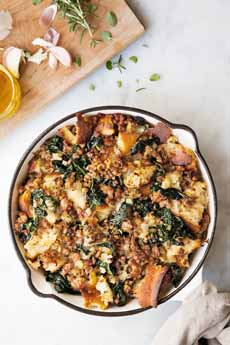RECIPE: Oyster Dressing & The Difference Between Stuffing & Dressing
|
|
Mom was an autocrat in the kitchen (a nicer-sounding word than synonyms like dictator, despot, tyrant, she agrees). Everything had to be exactly as she willed it. As she was a great cook, it was tough to complain.
Every Thanksgiving, her stuffing was made with white bread, sweet Italian sausage, celery, onions, fresh parsley, sage, and thyme. Want chestnut stuffing? Oyster stuffing? Cornbread stuffing? Go have dinner elsewhere! By the time we had our own kitchen, we had grown so used to Mom’s sausage stuffing that it was tough to rebel, except by switching out the white bread for cornbread. And, we switched to dressing over Mom’s preferred method of stuffing (the difference is below). We did shell chestnuts for stuffing for a couple of years before the wide availability of peeled, vacuum-packed chestnuts. But when you’re trying to save time, it’s easy to try another recipe. Fortunately, our grocer’s fish counter has all the oysters one can afford, shucked and ready to plop into the dressing. This year, we received a classic oyster stuffing recipe from Sandy Ingber, “The Bishop of Bivalves” and executive chef of the Grand Central Oyster Bar. If you don’t want to make it yourself, the restaurant is selling it for $18/pound, ready to pick up between 12 noon and 8 p.m. on November 21st. Orders may be placed by emailing info@oysterbarny.com, by calling 212-490-6650, or in person at the Oyster Bar. Place your order no later than Monday, November 20th. Otherwise: Cook away! This recipe can be made up to 2 days in advance. Ingredients |
|
|
Preparation 1. DRY the cut bread cubes overnight, or toast them in a low-temperature oven (115°F-185°F) until crisp. 2. PREHEAT the oven to 350°F oven. Melt half the butter in a medium skillet. Add the onions and celery, cooking until the onions are translucent (about 5 minutes). Add the garlic, sage, thyme, and nutmeg; cook for 30 seconds more. 3. COMBINE the cooked vegetables with the bread cubes, parsley, stock, milk, and eggs, mixing gently. Fold in the oysters. Season with salt and pepper. If making dressing in a separate pan… 4. TRANSFER the mixture to a large greased baking dish. Dot the surface with pats of the remaining butter. Lightly oil both sides of a piece of parchment and place on top of the dressing. Bake until it is crisp on top and the stuffing temperature reaches 160°F (check after 40 minutes). It’s simple: For food safety reasons, stuffing in the cavity of the bird must reach the same 165°F temperature before it is ready to serve. If you have a vegetarian dressing, it’s not an issue. (But if you have a dressing made with raw meat or seafood, do make sure it cooks to 160°F.) It’s also a heck of a lot easier to make dressing, both in placing it in a pan instead of spooning it into the turkey cavity; and in avoiding the labor of scooping the stuffing out of the bird. |
||


